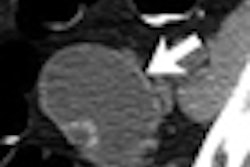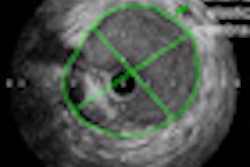Virtual colonoscopy offers several advantages for the surveillance of patients after curative colon cancer surgery, according to a new study published online in Radiology. In more than 700 patients, VC detected 100% of the metachronous or recurrent cancers, along with several unsuspected extracolonic cancers. At the same time, VC missed a few noncancerous lesions, including 19 advanced adenomas.
The 11 extracolonic cancers detected by VC (also known as CT colonography or CTC) would not have been found in the conventional colonoscopy exam, noted study authors Hye Jin Kim, MD; Seong Ho Park, MD; and colleagues from Asan Medical Center in Seoul, Korea, along with Perry Pickhardt, MD, and colleagues from the University of Wisconsin in Madison.
Following curative resection for colon cancer, "both colonic and extracolonic surveillance are needed because more than half of recurrent tumors will manifest as distant extracolonic metastatic disease, and many local recurrences lack an intraluminal colonic component," they wrote (Radiology, September 27, 2010).
However, intensive colonoscopic surveillance may be "somewhat superfluous" due to its low diagnostic yield in such patients -- one metachronous cancer per 157 surveillance colonoscopies, according to one study.
Contrast-enhanced CTC is an attractive candidate for both colonic and extracolonic surveillance, having been validated for use in some screening patients and in surveillance postcolonoscopy, they wrote. But because surveillance data are limited in postsurgical patients, the study was performed to determine the accuracy of contrast-enhanced CTC for postoperative surveillance in patients postsurgery.
The group examined 742 consecutive patients (419 men, 383 women; mean age, 58.9 years ± 10.9; range, 19-85 years), who had no clinical or laboratory evidence of recurrence following colorectal cancer surgery with curative intent. Subsequent colonoscopy and pathologic confirmation of colonic lesions was performed in 548 of the 742 patients, while analysis of extracolonic findings was performed in all 742 patients who underwent virtual colonoscopy.
The research was enabled by a minor change in the institution's routine cancer surveillance guidelines in 2006, from contrast-enhanced abdominal CT to CTC.
Following cathartic bowel cleansing and prone/supine CT colonography scans, images were examined by one of two experienced radiologists. The study team recorded the sensitivity and specificity of CTC for nonanastomotic colonic lesions 6 mm and larger, as well as anastomotic lesions of any size. Conventional colonoscopy served as the gold standard.
VC detected 100% of the recurrent cancers in the cohort, all of which were amenable to additional curative treatment, including six metachronous cancers and one anastomotic recurrence within the colon in six patients.
An additional 209 nonanastomotic lesions 5 mm or smaller found at colonoscopy were excluded from the analysis; none were advanced adenomas or adenocarcinomas, the authors wrote. There were 120 colonic lesions 6 mm or larger, 118 of which had histopathologic findings available. In all, 79 (83.2%) of 95 histologically confirmed nonanastomotic lesions and one (4.3%) of 23 anastomotic lesions were neoplastic (p < 0.001).
Per-patient and per-lesion CT colonography sensitivity was 78.5% or greater for all histopathologic categories of colonic lesions, Kim and colleagues wrote. CTC's specificity was 93.1%.
Importantly, CT colonography depicted all seven cancers within the colon. However, it missed a total of 12 6- to 9-mm lesions among the 53 nonadvanced adenomas, five 8- to 15-mm lesions among the 19 advanced adenomas, and seven 5- to 10-mm lesions among the 38 nonneoplastic lesions.
Causes for missed lesions at CTC included flat morphology (n = 10) and size discrepancy, i.e., lesions were thought to be smaller than 6 mm at CTC but found to be larger at colonoscopy (n = 3). One was hidden by residual stool, one by suboptimal distention, one was missed due to reader error, and causes were not given for eight missed lesions. CTC was considered inadequate in 19 (2.6%) of the 742 patients, due to excessive untagged fecal matter in 10 patients and poor distention in nine.
All cancer lesions within the colon were amenable to curative treatment. CTC's per-patient and per-lesion sensitivity were 81.8% and 80.8%, respectively, for advanced neoplasia and 80.0% and 78.5%, respectively, for all adenomatous lesions.
CTC's negative predictive value was 100% for adenocarcinoma, 99.1% for advanced neoplasia, and 97.0% for all adenomatous lesions, with specificity of 93.1%. Contrast-enhanced CT colonography enabled detection of extracolonic recurrences in an additional 11 patients (1.5%).
The 11 patients with recurrent cancer manifesting as metastatic disease were identified 10 to 42 months (median, 18) after the initial surgery. The findings included four patients with rectal cancer, three with sigmoid colon cancers, one with cancer in the sigmoid colon, and two with cancers in the cecum. The 11 patients with extracolonic malignancies had a total of five stage III cancers, five stage II cancers, and a single stage I cancer. These were located in the liver (n = 5), lungs (n = 4), peritoneum (n = 1), and adnexa (n = 1).
Seven patients with hepatic, pulmonary, or adnexal metastasis received additional curative treatment, while the remaining four patients "were not amenable to repeat curative treatment," the authors stated.
As for referrals to colonoscopy, the maximum referral rate would have been 19% (140 of 742) if all patients with positive CTC results (n = 121) or inadequate CTC exams had undergone subsequent colonoscopy. This is higher than the typical rate of approximately 9% for patients undergoing screening CTC but acceptable for surveillance exams in this population, Kim and colleagues wrote.
CTC's diagnostic accuracy was comparable to that of screening CTC and, importantly, reached 100% for colon cancers while enabling the detection of clinically unsuspected extracolonic metastatic disease in 11 patients, none of whom had cancerous lesions in the colon, the authors wrote.
"The many advantages of contrast-enhanced CT colonography, including excellent diagnostic performance, dual colonic-extracolonic assessment, less invasive nature, and higher safety profile, all support its use in routine postoperative surveillance of colorectal cancer patients and may suggest that negative results at the CT colonography could exclude the need for surveillance colonoscopy during the same time frame," the authors wrote.
On the other hand, "the fact that a small number of benign adenomas, including five of 19 advanced adenomas, were missed at CT colonography may raise some concerns about the substitution of colonoscopic surveillance with CT colonography," they wrote. "Therefore, concerns regarding the adenomas missed at CT colonography, particularly those with advanced histologic features, need to be further resolved."
Overall, however, CTC is an accurate and practical surveillance tool that would allow for "simultaneous less-invasive evaluation of both colon and extracolonic organs," the authors concluded.
By Eric Barnes
AuntMinnie.com staff writer
October 12, 2010
Optical colonoscopy finds more tiny adenomas, October 1, 2010
Study finds VC cost-effective if tiny polyps are ignored, September 9, 2010
Surveillance colonoscopy best for high-risk patients, June 23, 2010
Screening VC sorts out incidental kidney lesions, June 15, 2010
Massive VC study yields trove of extracolonic cancers, March 23, 2010
Copyright © 2010 AuntMinnie.com



















